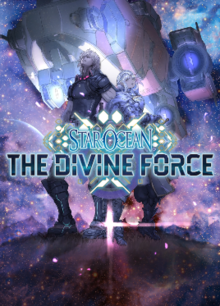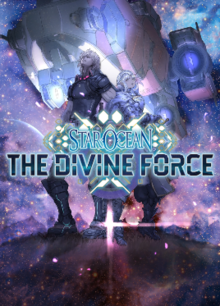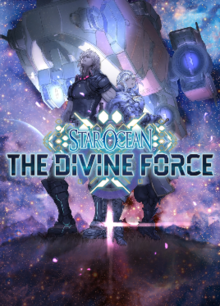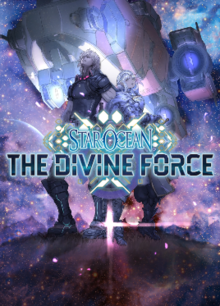
Star Ocean: The Divine Force (PS5) - Review
by Thomas Froehlicher , posted on 07 December 2022 / 3,009 ViewsWhen Star Ocean: Integrity and Faithlessness released six years ago the reception was so underwhelming that even the most hardcore of Star Ocean lovers - including myself - lost all hope. Star Ocean: Till The End of Time (the third entry, which released on the PS2 nearly 20 years ago) is in my top three favorite games of all time though, so I could still barely express my delight when Star Ocean: The Divine Force suddenly appeared during one of those usually soporific State of Play events. But I've never started a game by praying so much for it to be good. It had to be good.
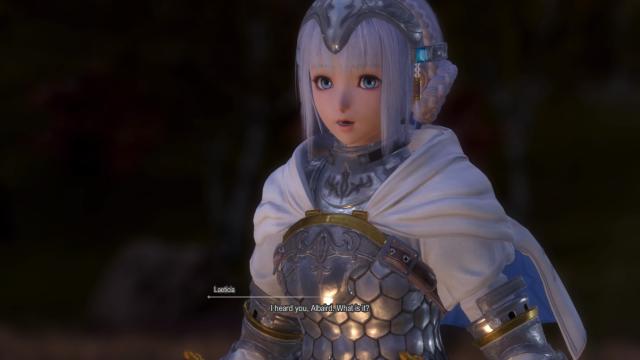
Star Ocean as an RPG series is most famous for mixing heroic fantasy with space opera. The story here opens on Aster IV, a planet where civilisation revolves around chivalry and feudal states. Raymond, a space freight merchant, crashes after an unexpected attack in outer space. He's spotted by Laeticia, the knight princess of a neighbouring kingdom. Despite belonging to drastically different worlds, they agree to journey together.
Amidst this blatantly classic Star Ocean pitch, The Divine Force brings something new: you can choose your main character, and thus determine which side you witness the story from. If you choose Laeticia, you start on the planet and don't see anything of Raymond's vessel when it gets attacked, whereas you do if you opt for him instead. On numerous occasions during the story, Raymond and Leaticia part ways for various reasons, leaving you to experience what happens to your chosen character. That means different places, different events, and different fights at certain points during the adventure, and also a good reason to replay it.
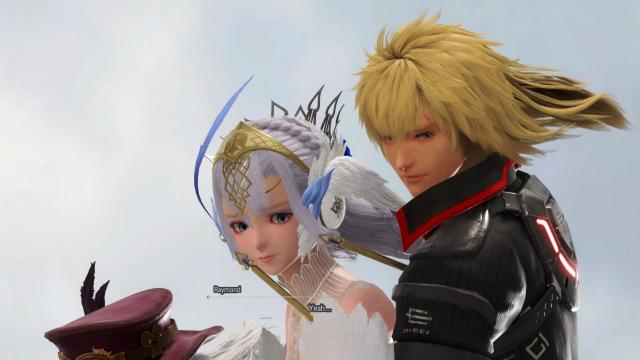
Regardless of which character you choose, the narrative is uneven. Not bad, just very uneven. Like every game in the series, Star Ocean: The Divine Force is partly based on a planet and partly based in space. The planet part relates the conflict between Leaticia's kingdom and the aggressive Empire that neighbours it. It's very heroic-fantasy oriented, so much so that it doesn't even feel like you're playing a Star Ocean title, and it's terribly paced. It's striking how the story fails to raise the stakes for such a long time. You collect new characters one after another while defeating fiends and imperial soldiers, all without witnessing any spectacular events or cut scenes. There's even a bad copy of Final Fantasy X's wedding scene. You see it coming from miles away, so it barely makes an impact.
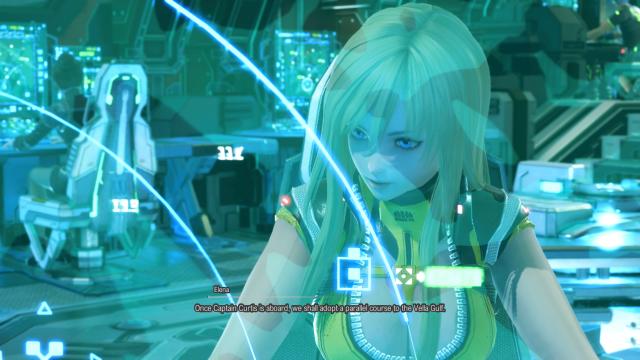
The PlayStation 5 has a funny new feature that proves quite useful for the purposes of this review: the system tells you the current completion percentage of whatever you're playing. This way, I can say for certain that the space element of Star Ocean: The Divine Force accounts for 27% of the game scenario (it started by the time my PS5 was showing 73% completion). It's... small, which is all the problematic given that Star Ocean: Integrity and Faithlessness failed precisely because it had next to no space opera element. In Star Ocean: Till The End of Time, the balance was much better between these two aspects, and there were also futuristic elements during the planetary segment that gave the impression of it being a fully sci-fi RPG.
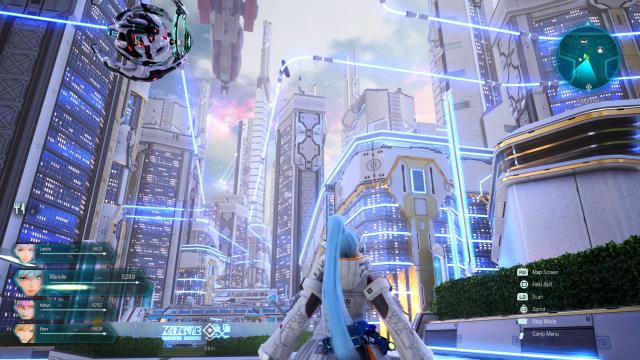
Star Ocean: The Divine Force thus fails to revive the incredible pacing in Star Ocean: Till The End of Time. Yet, however small that 27% of the game may seem, it's quite compelling. Not only does it give a genuine taste of space odyssey, with spaceship wars, hi-tech cities, and futuristic foes, but it also provides a long-awaited story twist. Raymond's team discovers the Galactic Federation's true nature and confront an advanced civilisation called Scorpium, which advocates the cybernetization of human body and mind. It's got more surprises, more charismatic opponents, and, above all, lots of thought-provoking narrative. Exactly what a JRPG needs. This all comes a bit late in the day, but it's there - and it's enjoyable.
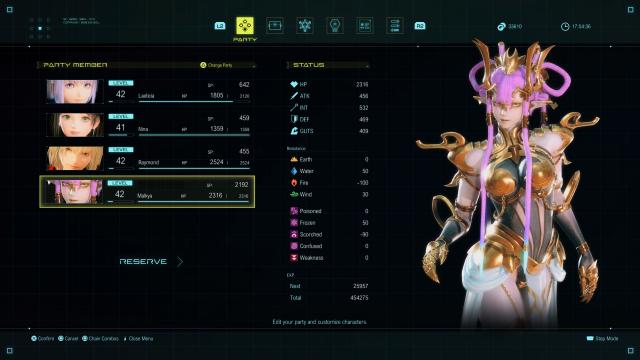
The character cast is further proof that tri-Ace and Square Enix has gone to great effort to revive Star Ocean's former glory. There are no less than eight playable main characters, including some very diverse profiles, although there is still some skill imbalance. Nina, for example, can only heal and has no offensive capability. Yet, other than Nina, each protagonist has a decent list of attacking skills. You can unlock the ones that suit you best from the skill tree and then organize them into combos that you set yourself in terms of attack order. As the skill tree is non-linear, you can achieve your ideal skill list and combos fairly quickly. The level of choice and freedom is very much appreciated here.
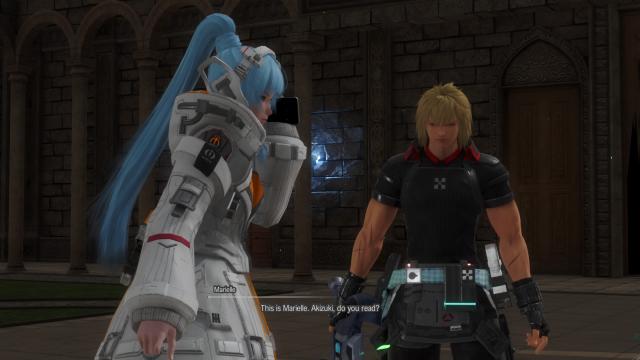
Also much to my liking: Star Ocean: The Divine Force includes strong influences and references to Star Ocean: Till The End of Time, with certain characters being the most striking manifestations of this. Elena is a near perfect successor to Mirage thanks to her remarkable design, although she is an android and fights a little differently. The nostalgia appeal is even more obvious in the case of Marielle, who's got the same hair color, weapon, moves, and almost the same name as Maria from Till The End of Time. This latest installment also inherits the tradition of having party members scattered across towns. You can locate them by searching every corner and, from time to time, you'll run into what are called Private Actions, where your current main character discusses personal stuff with them. You get a decent amount of character development from this, since you discover their pasts, goals, worries, and so on.
So in terms of character department Star Ocean: The Divine Force proves to be quite satisfying. Yet if I could voice one last preference on this topic, I'd argue that Star Ocean should go to the end of its logic in shifting back to Till The End of Time's standards by re-introducing anime-style design. Anime-themed artworks were dropped from the first western version of Star Ocean: The Last Hope (to be included again in the "International" PS3 version), and that became a series norm for some unfathomable reason. In my view that clearly didn't help Star Ocean: Integrity and Faithlessness to gain more recognition at the time, and while the characters in The Divine Force look absolutely superb (the female characters, at the very least), anime-looking art and modeling would draw more Japanese gaming fans to the series than today's "realistic-looking" standards.
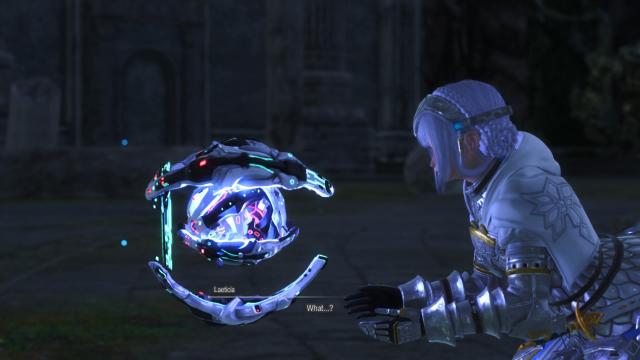
I have very little recollection of battle systems from The Last Hope or Integrity and Faithlessness, but I'll certainly remember the very innovative one featured in this entry for some time to come. The cornerstone of your strategy here is a high-tech orb called DUMA. The DUMA can thrust you forwards and close the distance to an opponent, but if you make a turn and leave the enemy's field of vision, you trigger what is called a Blindside. Blindsided foes get startled and take more damage. Each successful Blindside grants you more AP, which you need to use attack skills. So the more skilled you are, the greater your AP reserve, and the longer and more powerful your combos become. There are also several more stimulating mechanics, although they are less innovative. For example, the DUMA can leave your current controlled character and adopt a defensive state, protecting your allies. You can also perform an evade by hitting the dodge button right before the enemy strikes, which charges the DUMA (Blindside takes its energy). There's a fast and truly dynamic feel to Star Ocean: The Divine Force, one that's even stronger in boss fights where opponents hit hard.
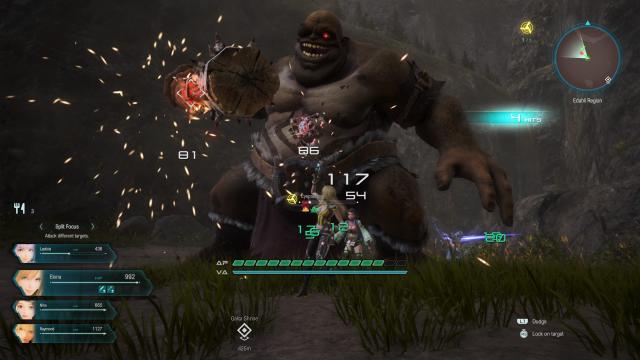
But the combat hits a snag when you think about the challenge level; enemies are sometimes very weak and passive skills are far too protective. Auto-heal is to blame here (it's Final Fantasy IX all over again); I found myself regularly removing or reactivating auto-heal, as well as changing between the Galaxy and Universe difficulty settings depending on the situation (the latter being the hardest). I don't remember ever having to do that in past Star Ocean games. It left me with the awkward impression that I was balancing the game instead of the developers. Fortunately the endgame is much tougher and certainly fun to play, as you're pushed to take full advantage of all DUMA and combo skills. It's just too bad that bosses can only be Blindsided on a few occasions, because this leaves you with low AP to develop your combos. It's a minor drawback that maybe needs to be thought through by the developers.
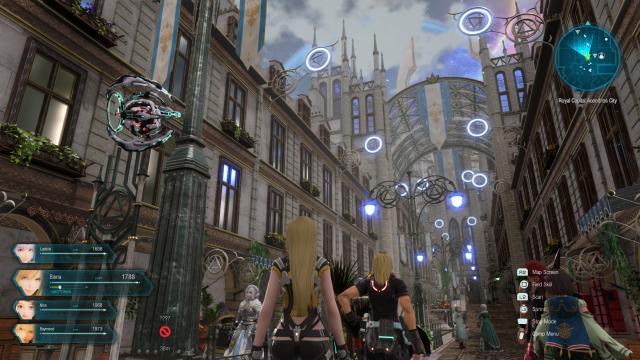
Visually, Star Ocean: The Divine Force boasts astonishingly gorgeous towns. Honestly, no RPG I've played recently has towns like these. They're so densely architectured, with either magnificent pastoral houses or massive castle structures, that I could hardly believe my eyes. They're also lively, partly thanks to numerous NPCs chatting along in the streets. Some of these NPCs give you tasks as side quests that are considerably more interesting to take up than those in Star Ocean: Integrity and Faithlessness, because you often have to search the whole planet to complete them. The cities are also fairly large compared to the previous game, and offer no less epic music. "Millenium Capital" has an impressive chorus very much befitting the heroic fantasy atmosphere, "The Vey'l March" has a grave tone that suits the Empire as a theme, and "Eternal Heat" is simply the best Ghost in the Shell-like song I've ever heard. I could go on, describing several more excellent tracks, this undoubtedly being my favourite soundtrack of the year so far.
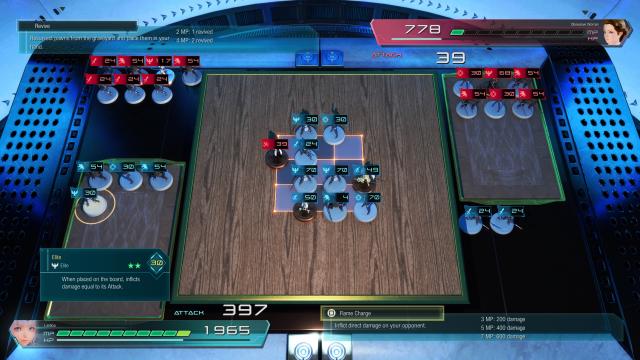
Last, but certainly not least, the developers did their utmost to craft a deeply addictive mini-game, which is something they seem to have a knack for. Es'Owa is an elaborated version of Go, played with different kinds of figurines. Each player has a HP bar, and every figure placed on the board deals damage to the opponent's HP until one player reaches 0 HP. Interestingly, there are several types of figurines with different roles. Amongst others, the Mage boosts the power of nearby figurines, the Elite deals double damage in one round, and the ultra-rare Hero increases its own power with every turn! You can also take your opponent's figurines by cornering them on the board, just like you can in Go. But the absolute killer feature of Es'Owa is its enormous collection of figurines, with numerous rare pieces being represented by former Star Ocean characters.
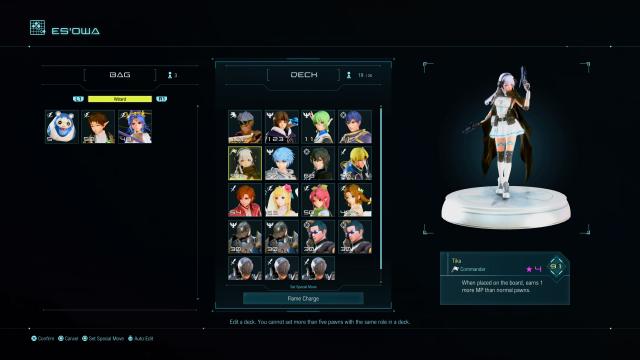
There are countless NPC Es'Owa players in the game (several in every town), and each time you get a new rare piece if you win. Furthermore, Es'Owa is organised into leagues and levels, from Beginner to Master. If you want to progress in the league, you have to beat at least one person who's exactly one level above you. It's very progressive, with better leagues playing on bigger boards and Masters having terrific pieces. The thirst for rare figures is real, either for collecting your favorite Star Ocean characters or climbing the ranks. The rules are so well thought through and the collection so appealing that I spent hours defying nearly every player in the world. Es'Owa is, in my honest opinion, Triple Triad levels of awesome, and that ranks it among the very best mini-games in an RPG from the last 20 years.
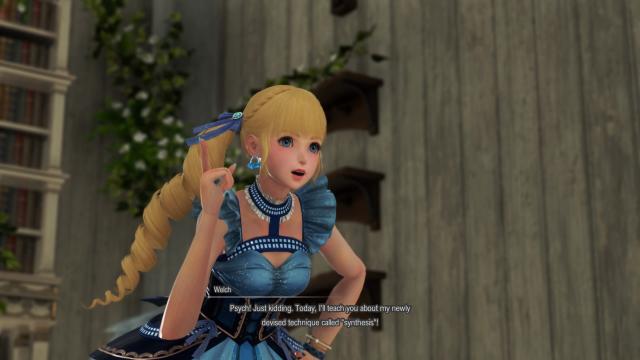
But when you think mini-games and Star Ocean, Invention comes immediately to mind. The Divine Force maintains this tradition, with a lengthy sidequest provided by the game's Welch (a recurring character in Star Ocean, like Final Fantasy's Cid), who bestows various fields of expertise (alchemy, crafting, engineering, etc.) in exchange for running errands. With every new speciality, the main characters are able to make items from materials. But while Welch is an extremely fun secondary character for her self-important tone and tendency to boss the protagonist around, the item creation in itself doesn't feel any better than it did in Integrity and Faithlessness. After many retries in various fields, maximum competence level, and ultra-expensive materials, I could barely make exclusive items. Indeed, Till The End of Time set the bar so high in terms of item creation that The Divine Force doesn't offer enough depth to even remotely match its legendary predecessor in this respect. However, crafting can produce some of Es'Owa's rarest pieces, which makes it worthwhile.
One of the first things I thought while playing Star Ocean: The Divine Force was that it was putting the series back on the right track, but it ultimately does more than that. It takes enough from Star Ocean: Till The End of Time in terms of spirit to fill series veterans with wonder, while also bringing new and compelling content to the table in terms of battles, characters, graphics, world design, and mini-games. This makes it a delightful RPG in its own right, rather than just a good retro-like experience.
After graduating from a French business school, Thomas felt an irresistible force drawing him to study Japanese, which eventually led him to Japanese Profeciency Test level 1 in 2012. During the day, Thomas is a normal account manager. But at night he becomes Ryuzaki57, an extreme otaku gamer hungry for Japanese games (preferably with pretty girls in the main role). His knowledge now allows him to import games at Japanese release for unthinkable prices, and then tell everyone about them. You may also find him on French video games media. Feel free to contact on twitter at @Ryuz4ki57
VGChartz Verdict
8
Great
This review is based on a retail copy of Star Ocean: The Divine Force for the PS5
More Articles
I'm glad to hear the series take a positive turn for a change. I fell off the series after SO4, so this might be a good time to check back up on it.
8 is a good score, gives me hope. I played SO3 and enjoyed it a lot, the animation was okay for it's time and style and it has a unique take on action RPG battle system. 4 and 5 carried this over but due to other things I never finished them. 4 had terrible sound and voice acting, put me off and 5 just felt like it was churned out.
I played the demo. I had fun during the time, the exploration to combat felt good and more refined than the last game. World more thought out too (Plus there was a giant bunny people just were ignoring... like giant bunny).
This review and the demo has made me consider picking it up. In a sale maybe. However I will note one thing. Square used to be the king of JRPGs, SquEnix carried on that to a point but their latest entries into this long running series feel, to me, to have all merged into the same 'actionRPG' format. SO6, Valk Elysium and even FF. They are in essence the same thing. What separated them in terms of gameplay is becoming less defined, which is a shame. To me, SO and VP new entries feel like the new FFs but on a budget. Or more that FF is Star Ocean on a high budget.
How is the text size? It bordered on annoying in the demo. Everything was voiced so it didn't bother me.. but It may have in the future.
Any changes?
I really enjoyed this game as well. I would give it an 8 also.
























